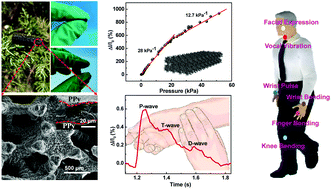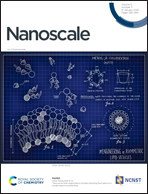Extending the pressure sensing range of porous polypyrrole with multiscale microstructures†
Abstract
Polymer-based piezoresistive sensors that combine the flexibility and stretchability of organic polymers have received considerable attention in flexible and wearable sensing systems. Generally, highly sensitive pressure sensors have a limited pressure sensing range, while pressure sensors with a wide pressure response range usually have limited pressure resolution. Herein, we used a polypyrrole (PPy) sponge with multiscale porous structures to extend the pressure sensing range of PPy-based piezoresistive sensors. The multiscale microstructures with different sizes will sink in sequence after increasing the external pressure and therefore exhibit a wide pressure response range. Our results show that the piezoresistive composite has a superior sensitivity of 28 kPa−1 and a broad stress range of 0–60 kPa. Moreover, the composite displays a stable, repeatable and durable performance over 16 000 cycles. It can be used to monitor diverse body part motions, including vocalization, pulse beating and joint bending. This work provides an effective strategy to extend the pressure sensing range of polymer-based piezoresistive sensors in the manner of structure design rather than modifying the intrinsic properties of active materials.



 Please wait while we load your content...
Please wait while we load your content...